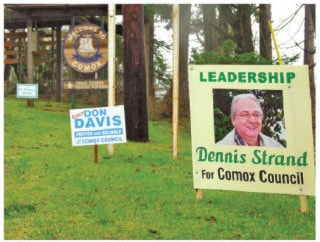Election signs — an eyesore or a necessary part of a political campaign?
First-time Comox council candidate Nico teWinkel favours the former as he prepares for next Saturday’s byelection that will determine who fills the seat once occupied by the late Ray Crossley. In fact, teWinkel feels campaign signs are a form of pollution and manipulation, as opposed to a source of information about candidates.
So he will not use signs — period — opting instead to rely on social networking methods such as Facebook, and to work with the media to introduce himself to the public. He has even created an iPhone app.
“It just felt like the right thing to do,” teWinkel said. “It’s taking a chance. I might be losing out that way. (But) I feel it’s better for people to take a moment and look at what the candidates really are all about.
“Even for myself, if somebody wants to build high-rise towers in Comox and they read my blurb, they shouldn’t vote for me because I’m not the right guy to represent them.”
Fellow first-time candidate Derek Bouchard does not want to “mire the landscape” with an abundance of signs, preferring also to utilize social networking.
“I think it’s a great way to interact a little more than just putting a sign up,” Bouchard said.
Pat McKenna decided to use signs to get his name out there — private yards being the primary location — but he understands the efforts of fellow candidates who choose the technological route.
“We made them recyclable, in the event that we run again,” McKenna said.
Hugh MacKinnon feels campaign signage is an “infringement of public green space,” especially during the Christmas season.
Wanting to be more than a name on a sign, he prefers to discuss issues on a face-to-face basis. That said, MacKinnon is not knocking those who decide to use signs.
“Certainly, people have every right to put a sign on their private property,” he said. “All fair in politics. I’m hoping that people examine the candidates for what they stand for, more than just name recognition.”
Former Comox councillor Don Davis is not opposed to signs on public thoroughfares, “as long as they don’t get too obnoxious.
“It’s a very cost-effective way for someone to campaign,” Davis said. “I’ve been using my signs since 1996...Most people think it’s just part of the process.”
Noting the issue comes up every election, former Comox councillor Dennis Strand feels it is up to the candidate whether he or she wishes to erect a sign, as long as it abides by town bylaws.
“We try to put as many as we can on people’s yards,” Strand said, noting the short period of time leading up to an election. “I just wish all the candidates all the best.”
Amie Anderson, who also once sat on council, has eight signs she plans to place in convenient places, mostly residential.
“I didn’t make any new signs for this time,” she said. “I know we all want to be environmentally conscious, and I’m one of them.”
Barbara Price, another former councillor, is also reusing signs from previous campaigns.
“All my signs are on private property and have been requested,” she said.
reporter@comoxvalleyrecord.com



